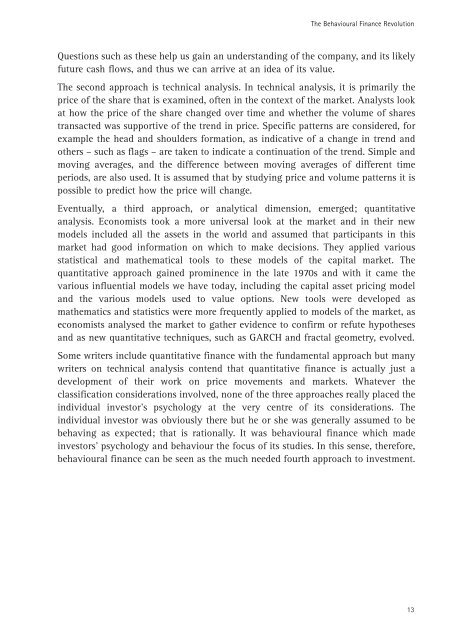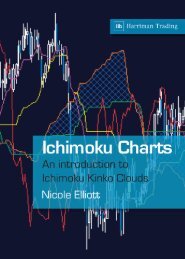Read a PDF Sample of Behavioural Technical ... - Harriman House
Read a PDF Sample of Behavioural Technical ... - Harriman House
Read a PDF Sample of Behavioural Technical ... - Harriman House
You also want an ePaper? Increase the reach of your titles
YUMPU automatically turns print PDFs into web optimized ePapers that Google loves.
The <strong>Behavioural</strong> Finance Revolution<br />
Questions such as these help us gain an understanding <strong>of</strong> the company, and its likely<br />
future cash flows, and thus we can arrive at an idea <strong>of</strong> its value.<br />
The second approach is technical analysis. In technical analysis, it is primarily the<br />
price <strong>of</strong> the share that is examined, <strong>of</strong>ten in the context <strong>of</strong> the market. Analysts look<br />
at how the price <strong>of</strong> the share changed over time and whether the volume <strong>of</strong> shares<br />
transacted was supportive <strong>of</strong> the trend in price. Specific patterns are considered, for<br />
example the head and shoulders formation, as indicative <strong>of</strong> a change in trend and<br />
others – such as flags – are taken to indicate a continuation <strong>of</strong> the trend. Simple and<br />
moving averages, and the difference between moving averages <strong>of</strong> different time<br />
periods, are also used. It is assumed that by studying price and volume patterns it is<br />
possible to predict how the price will change.<br />
Eventually, a third approach, or analytical dimension, emerged; quantitative<br />
analysis. Economists took a more universal look at the market and in their new<br />
models included all the assets in the world and assumed that participants in this<br />
market had good information on which to make decisions. They applied various<br />
statistical and mathematical tools to these models <strong>of</strong> the capital market. The<br />
quantitative approach gained prominence in the late 1970s and with it came the<br />
various influential models we have today, including the capital asset pricing model<br />
and the various models used to value options. New tools were developed as<br />
mathematics and statistics were more frequently applied to models <strong>of</strong> the market, as<br />
economists analysed the market to gather evidence to confirm or refute hypotheses<br />
and as new quantitative techniques, such as GARCH and fractal geometry, evolved.<br />
Some writers include quantitative finance with the fundamental approach but many<br />
writers on technical analysis contend that quantitative finance is actually just a<br />
development <strong>of</strong> their work on price movements and markets. Whatever the<br />
classification considerations involved, none <strong>of</strong> the three approaches really placed the<br />
individual investor’s psychology at the very centre <strong>of</strong> its considerations. The<br />
individual investor was obviously there but he or she was generally assumed to be<br />
behaving as expected; that is rationally. It was behavioural finance which made<br />
investors’ psychology and behaviour the focus <strong>of</strong> its studies. In this sense, therefore,<br />
behavioural finance can be seen as the much needed fourth approach to investment.<br />
13
















